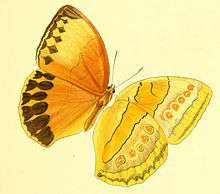Stichophthalma sparta
Stichophthalma sparta, the Manipur jungle queen,[1] is a butterfly found in South Asia that belongs to the Morphinae subfamily of the brush-footed butterflies family.
| Manipur jungle queen | |
|---|---|
 | |
| Scientific classification | |
| Kingdom: | |
| Phylum: | |
| Class: | |
| Order: | |
| Family: | |
| Genus: | |
| Species: | S. sparta |
| Binomial name | |
| Stichophthalma sparta de Nicéville, 1889 | |
Distribution
The Manipur jungle queen ranges from Assam (Abor Hills), Nagaland, Manipur across Myanmar (Kindat and Katha in the north; Htawgaw and Sadon in the north-east of the country, and Gokteik in the northern Shan states) onto northern Yunnan in China.[1][2]
Status
Evans reports the butterfly as not rare in Sikkim and Assam and as very rare in the Naga Hills.[2] Haribal reports the butterfly as rare in Sikkim.[3]
Description
Upperside of both males and females ochraceous yellow suffused with a darker, somewhat brownish shade of the same towards base of forewing and on hindwing. Forewing has a postdiscal transverse row of fleur-de-lys-shaped spots, a subterminal series of broad black lunules, followed by a series of narrow crescentic marks of the ochraceous ground colour; apex and a terminal line black. Hindwing has a subterminal series of black lunules as on the forewing, giving out inwards a series of large, shafted, roundly lanceolate marks of the same colour, followed, as on the forewing, by narrow ochraceous crescentic marks and a terminal black line, the marks posteriorly rather diffuse and tending to run together. Underside ochraceous yellow, with the following transverse markings: subbasal, median, postdiscal, sub terminal and terminal dark brown sinuous lines; a discal row of dark ochraceous ocelli, six on forewing, five on hindwing: and, bordering the ocelli on the inner side, a variable diffuse dusky-black band, ending posteriorly on the hindwing in a black tornal spot. Antennae dark brown; head, thorax and abdomen ochraceous, abdomen paler beneath.
Female upperside is similar, the black markings broader and heavier. Underside also similar, but the ground colour a beautiful pale green with a silky lustre, the median transverse dark brown line outwardly bordered from costa of forewing to vein 1 of hindwing with greenish white; the dusky-black transversely discal band broader and more diffuse: forewing with seven ocelli; terminal margins broadly but lightly infuscated.[4]
See also
Cited references
- "Stichophthalma C. & R. Felder, 1862" at Markku Savela's Lepidoptera and Some Other Life Forms
- Evans, W.H. (1932). The Identification of Indian Butterflies (2nd ed.). Mumbai, India: Bombay Natural History Society. pp. 132–133.
- Haribal, Meena (1992). The Butterflies of Sikkim Himalaya and Their Natural History. Gangtok, Sikkim, India: Sikkim Nature Conservation Foundation.
- Bingham, C.T. (1905). The Fauna of British India, Including Ceylon and Burma Butterflies. 1 (1st ed.). London: Taylor and Francis, Ltd. (under Stichophthalma howqua)
References
- Wynter-Blyth, Mark Alexander (1957). Butterflies of the Indian Region. Bombay, India: Bombay Natural History Society. ISBN 978-8170192329.